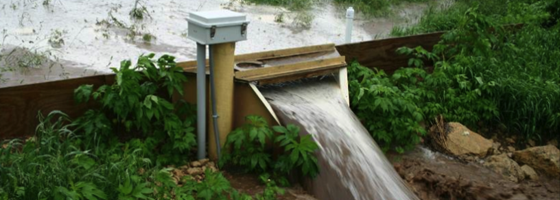Low-cost equipment to help monitor agricultural runoff in Lower Mississippi River basin

Farmers in the Mississippi River basin often hear agriculture is a leading contributor to hypoxia-fueling nutrient pollution, but rarely have a clear picture of what is flowing off of their fields and ultimately into the Gulf of Mexico. But a federal boost to a University of Arkansas Extension initiative could help make environmental monitoring technology more accessible to farmers who want that data.
“We felt like it was a great way to get farmers engaged into some of these issues,” said Mike Daniels, extension water quality and nutrient management specialist for the University of Arkansas System Division of Agriculture.
Around 10 farms already participate in a UA Extension monitoring program that uses automated samplers to measure the phosphorous, nitrogen and sediment leaving fields during rain events. The leaders in the state’s agricultural conservation community hoped to see the program grow, but that wasn’t going to come cheap.
The equipment and installation for a single sampling site can cost up to $15,000, Daniels said. A monthly chemical analysis costs around $100. At up to four samplers per farm and 48 analyses per year, the costs start to add up.
“You start to see this becoming an expensive thing, but it’s something that we definitely needed,” he said.
A $960,000 grant from the U.S. Department of Agriculture’s Natural Resources Conservation Service will help the extension program test low-cost monitoring technology that could equip interested farmers for edge-of-field monitoring for around a quarter of the price. The funding comes through the NRCS’s Conservation Innovation Grant Program.
The edge-of-field monitoring equipment that the grant will fund work similarly as the more expensive units. During a storm, a structure such as a flume directs runoff to the monitoring station. A sensor detects the flowing water, triggering a pump on the sampler to fill a bottle that will later be collected, processed and sent to a lab for analysis. A sensor continues to measure the flow, producing a hydrograph and the total volume of runoff that moves through the system. With the volume measurements and concentration levels derived from the sample, scientists can calculate the nutrient and sediment loads for the storm.
While the low-cost equipment, which has been under development at the University of Wisconsin-Platteville, serves the same purpose, it has the benefit of being specifically designed for this kind of monitoring.
“There’s nothing wrong with the equipment that’s available now,” said Dennis Busch, research manager at UW-Platteville’s Pioneer Farm. “It’s very good. It’s very powerful. But it’s designed to do a whole bunch of different things. That makes it a little more complicated to operate in the field and makes it more expensive.”
The new system saves costs with custom electronics designed with help from the university’s electrical engineering department. The developers also made creative use of off-the-shelf components, like a depth-measuring sensor originally designed to monitoring bilge water in ships.
“Ours is custom-designed to a single purpose, which is determine the discharge volume at edge-of-field sites, and collect a flow-based composite sample.” Busch said. “It doesn’t have the capabilities that you’ll see in other commercial units, but our focus was really to reduce costs.”
The NRCS grant will help test the new equipment at around 20 sites in Arkansas, Daniels said. Though the equipment has been tested in the Midwest, it’s important to assess how it performs under the unique water management regimes of Southern agriculture. For example, Southern farms tend to do much more irrigating. Precipitation, evapotranspiration and groundwater infiltration rates also differ between the two region.
The grant will also fund an effort to galvanize a network of environmental monitoring scientists throughout the Mississippi River corridor, Daniels said. That will include a conference in 2013 or 2014 and a training initiative to help build the capacity for furthering agricultural monitoring in the watershed.
“I think it’s some work that is very much needed and could really help us in these issues that we face with trying to make sure we can feed a hungry nation, but at the same time protect our natural resources,” he said.
Image: Runoff leaves a field through a flume like those used with the NRCS-funded, low-cost equipment (Credit: Randy Mentz/UW-Platteville)





0 comments